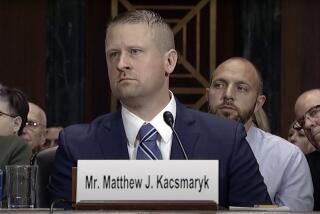Search for Male Contraceptive Makes Gains
- Share via
Joseph Velasco is no ranting men’s libber, no jockstrap-burning revolutionary, no militant masculinist, but since the spring of 1993, he has been engaged in an often painful struggle to win a measure of equality for men.
Once a week for more than a year, Velasco plunged a two-inch needle into a thigh muscle, dosing himself with 200 milligrams of testosterone.
The shot kicked like a cranky mule, and Velasco hobbled around his Mission Viejo house while his wife, Brenda O’Guinn-Velasco, teased him about his heroic role in the search for the male equivalent of the Pill.
Every other week, Velasco, 33, visited a Harbor-UCLA Medical Center clinic and donated semen. After several months of hormone injections, the clinic found that his sperm count had fallen dramatically.
“It was good news,” said Velasco, a purchasing agent, explaining that he would not have to wear a condom any more.
His wife called the clinic. “Are you sure?” she asked, skeptical that the preeminent male hormone could halt a process that is synonymous with manhood.
The clinic was sure.
Velasco was then a volunteer in the first large clinical study to show that regular doses of testosterone, long regarded as the essence of virility, can act as a contraceptive in the great majority of healthy men.
In the just-completed study, coordinated by the World Health Organization, 357 men in nine countries received weekly injections of testosterone enanthate, a synthetic form of the hormone. The method yielded just a 1.4% chance that a woman would become pregnant in a year.
That rivals the 3% failure rate of the Pill, in its first year of use, and is a vast improvement over that of the condom, the only other reversible male birth control method, which at best fails 12% of the time.
A new male method would be unlikely to set off a sexual revolution, as the Pill did in the ‘60s, the threat of AIDS and sexually transmitted diseases having done away with carefree conjugations.
Yet it would probably realign sexual relations in an era increasingly concerned about risks, rights and responsibilities. Population experts have long referred to men as the “missing 50% of family planning.”
“The importance of the study is that it shows that a male-directed hormonal contraceptive can be about as effective as the female-directed birth control pill,” said Dr. Ronald S. Swerdloff, an endocrinologist at Harbor-UCLA, who was involved in the study.
Susheela Singh, a demographer at the Alan Guttmacher Institute, the family planning research center, said she “would be excited if it was a safe, effective and affordable method. It’s something to really go after.” But she added that feminists and family planners alike, chastened by years of trying to get men more involved in birth control, “struggle against the underlying male resistance to sharing that responsibility.”
Serious Hurdles
Technical and even legal hurdles must be overcome before such a contraceptive reaches the U.S. market, and researchers are unwilling to predict how many years will go by before a form of it becomes widely available.
Harbor-UCLA and the University of Washington in Seattle are the two U.S. centers participating in the WHO study, which was funded largely by the Agency for International Development. A report on the study is due to be published this year.
In the first phase of the study, completed in 1990, the researchers gave weekly, 200-milligram testosterone injections to hundreds of men, and then identified the men who were sterile (whose sperm counts fell to zero). The men continued to endure the weekly hormone injections and biweekly sperm counts for a year, during which they had sex using no other contraceptive.
That showed encouraging results--the pregnancy rate was less than 1%--but was also limited, because only 60% to 70% of men can be expected to lose all sperm production in response to testosterone injections.
The second, more crucial phase of the study tested whether a man had to be sterile to be infertile. As Swerdloff put it, “Do you have to have complete absence of sperm in order to have a viable contraceptive?” A man normally produces 20 million to 200 million sperm per milliliter of semen, said William J. Bremner, a University of Washington endocrinologist involved in the study.
Fertility researchers have long observed that some men were incapable of causing pregnancy even though they had a sperm count of a few million, perhaps because defective sperm made up a higher proportion of the total count. “For some reason that no one quite understands, it takes a heck of a lot of sperm” for a man to be fertile, Bremner said.
In the second phase, the researchers studied men whose sperm counts fell to between 3 million and 5 million after testosterone injections. The pregnancy rate among couples including those men, who used no other contraceptive for a year, was equivalent to that of the female Pill.
This crucial result meant that this method had wider potential than previously believed, because 97.8% of healthy men tested reached those target sperm levels after testosterone treatment.
Swerdloff said, “If the sperm count is lowered to 3 to 5 million, contraception is very highly assured. And since most people get to that level,” he added, the method is “viable.”
It seems to be a paradox that shots of the ultra-male hormone could suppress sperm production. But scientists are perhaps only taking advantage of a fact that poets, feminists and observers of male sexual behavior have noted for ages: the brain and the testicles are intimately associated.
Sperm cells are produced in the testes largely in response to testosterone that is also produced there; but that hormone, in turn, is regulated by hormones from the body’s master endocrine organ, the pituitary gland, at the base of the brain.
Testosterone injections raise the blood level of the hormone so high that the pituitary, sensing a testicular surplus, stops stimulating the testes to crank out the hormone. Sperm production dwindles.
The injections can have side effects, the researchers found. Many men gained several pounds. In a sort of throwback to their hormone-raging teens, some men developed acne.
Previous studies have shown that testosterone injections can alter levels of cholesterol compounds in blood, perhaps increasing the risk of heart disease. And physicians remain deeply concerned about the added risk of prostate cancer because testosterone stimulates the prostate gland.
“We haven’t found any evidence for a prostate problem,” Bremner said. “But in fairness,” he added, the prostate risk “has to be stated as an unknown.”
For his part, Velasco, whose weight hovers around 200 pounds, said the injections added about six pounds. He suspects that he has lost some hair, but the researchers say they have not documented that problem among other research subjects.
And Velasco is convinced that in the first few weeks of treatment, his libido rose like the mercury in a Death Valley thermometer. However, the scientists tend to dismiss such observations as “anecdotal,” saying that the testosterone dose they are testing is high enough to let them have protected sex, but too low to affect how much they want to.
Among the main virtues of the testosterone contraceptive’s effects was its reversibility. “There hasn’t been a man yet--knock on wood--who has any suggestion of a failure to return sperm counts to normal,” Bremner said. Usually, production rebounds three or four months after the injections stop.
But as promising as these early results seem, the road to a safe, readily available chemical birth control method for men looks bumpy and maybe long.
For one thing, a two-inch intramuscular needle is something that a lot of men dread almost as much as unplanned fatherhood.
So researchers are working on testosterone compounds, taken alone or with other drugs, that could suppress sperm for months at a stretch, requiring perhaps only a few injections a year.
Meanwhile, scientists have all but ruled out a testosterone pill because the digestive system breaks down much of the hormone and massive oral doses can cause liver damage.
But the problem that most deeply troubles some scientists won’t be solved in the lab. It goes to the heart of American society, some say the American character: litigiousness.
According to the Pharmaceutical Research and Manufacturers of America, six of the eight major drug companies working in this area a decade ago have abandoned birth control research and development in the last decade because of an extraordinary number of product liability lawsuits.
The problem was addressed Wednesday at a Senate Judiciary Committee hearing. It examined whether people harmed by drugs or medical devices with Food and Drug Administration approval should be exempted from winning punitive damages, as the law now allows.
Janice Toran, general counsel for G. D. Searle, a Chicago-based drug company, said in testimony: “Searle, the first company to market a birth control pill in this country, is now reluctant to conduct any research in the area of reproduction. Regrettably, this is not an isolated instance.”
The inventor of the Pill, Carl Djerassi, a Stanford University chemist, described the current legal and regulatory environment as “deplorable.”
Referring to the testosterone contraceptive studied by the WHO, he said, “There isn’t a ghost of a chance that it will be used in the States.” Djerassi said that given the threat of liability lawsuits, “there isn’t a company that’s interested” in investing the vast sums it would take to usher such a product through studies for Food and Drug Administration approval.
Though Swerdloff said “the failure of the pharmaceutical industry” to pursue male contraception “has been inhibiting” to research, he is not wholly pessimistic about the future. “My feeling is that the groundwork is being laid for much wider use of male-directed hormones,” he said.
Male Stereotype
The latest WHO study has done nothing to clear the caustic legal atmosphere, but it has offered evidence to dispel one nagging concern: machismo.
For years, population experts have noted that men, ever the hunters and gatherers, view contraception as women’s work.
Bremner, a 20-year veteran of contraception research, said the notorious male reluctance is “baloney,” adding: “We don’t have any trouble getting men for our studies.”
He said many men wanted to continue the injections after the study ended.
Bremner said he has been attacked by some feminists for dragging his feet on developing a male contraceptive and by others for working on a method that might disempower women. He added, “But most women don’t want to worry about contraceiving all the time. Stable couples need contraception for decades, and there seems to be more and more pressure on men to share some of the risks.”
Perhaps surprisingly, the oft-needled Velasco has enrolled in another research project run by Harbor-UCLA. Once a week, he injects himself with testosterone--a lower dose this time. In addition, every morning he jabs his belly with a quarter-inch needle delivering a drug that interferes with pituitary hormones involved in sperm production. The drug makes his skin feel as though he was attacked by fire ants.
He was a psychology major in college, he said, and it was the idea of seeing a research project from the inside that originally drew him into the first one. Conceding that sometimes he has to get “psyched up” to face the hypodermics, he said he enjoyed giving his wife a break and shouldering the birth-control burden. He said, “It’s nice to have a choice.”
More to Read
Sign up for Essential California
The most important California stories and recommendations in your inbox every morning.
You may occasionally receive promotional content from the Los Angeles Times.










